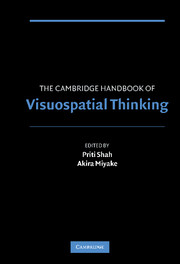Book contents
- The Cambridge Handbook of Visuospatial Thinking
- The Cambridge Handbook of Visuospatial Thinking
- Copyright page
- Contents
- List of Contributors
- Preface
- Acknowledgments
- 1 Functional Significance of Visuospatial Representations
- 2 Visuospatial Images
- 3 Disorders of Visuospatial WorkingMemory
- 4 Individual Differences in Spatial Abilities
- 5 Sex Differencesin Visuospatial Abilities
- 6 Development of Spatial Competence
- 7 Navigation
- 8 Mapping the Understanding of Understanding Maps
- 9 Spatial Situation Models
- 10 Design Applications of Visual Spatial Thinking
- 11 The Comprehension of Quantitative Information in Graphical Displays
- 12 Multimedia Learning: GuidingVisuospatial Thinking with Instructional Animation
- Author Index
- Subject Index
10 - Design Applications of Visual Spatial Thinking
The Importance of Frame of Reference
Published online by Cambridge University Press: 05 June 2012
- The Cambridge Handbook of Visuospatial Thinking
- The Cambridge Handbook of Visuospatial Thinking
- Copyright page
- Contents
- List of Contributors
- Preface
- Acknowledgments
- 1 Functional Significance of Visuospatial Representations
- 2 Visuospatial Images
- 3 Disorders of Visuospatial WorkingMemory
- 4 Individual Differences in Spatial Abilities
- 5 Sex Differencesin Visuospatial Abilities
- 6 Development of Spatial Competence
- 7 Navigation
- 8 Mapping the Understanding of Understanding Maps
- 9 Spatial Situation Models
- 10 Design Applications of Visual Spatial Thinking
- 11 The Comprehension of Quantitative Information in Graphical Displays
- 12 Multimedia Learning: GuidingVisuospatial Thinking with Instructional Animation
- Author Index
- Subject Index
Summary
When humans perform tasks involving spatial cognition and visual spatial thinking, like navigation, vehicle control, manual manipulation, or understanding of the structure of data, they must often deal with displays and controls of the work environment that are represented in different frames of reference. Such thinking is challenged by the need to perform transformations between these different reference frames. The frame of reference can be defined by three axes of translation and three axes of orientation, each with either static or dynamic properties. In this chapter we describe important human performance limitations that constrain visual–spatial thinking, as these are related to mental rotation and transformations of location. We describe how these limits have important implications for the design of different displays that support the user of three-dimensional spatial information, and support the user’s understanding of three-dimensional motion. Finally, we describe the implications of visual spatial thinking to two particular applications: helmet-mounted displays and information visualization.
Keywords
- Type
- Chapter
- Information
- The Cambridge Handbook of Visuospatial Thinking , pp. 383 - 425Publisher: Cambridge University PressPrint publication year: 2005
- 35
- Cited by



